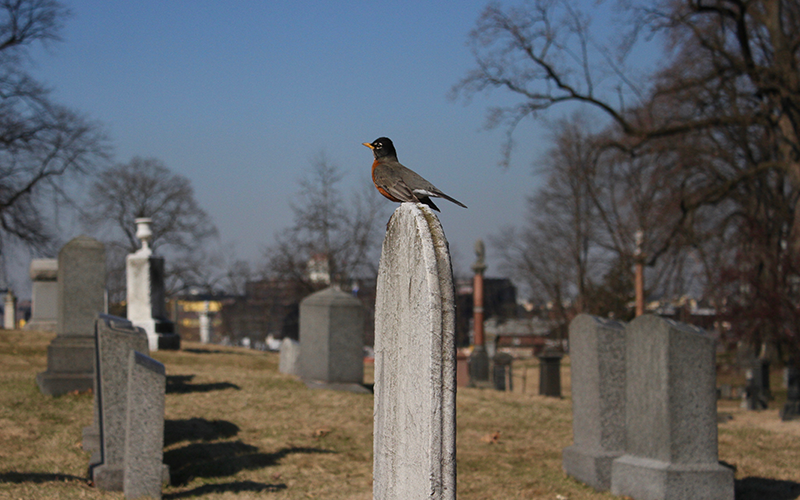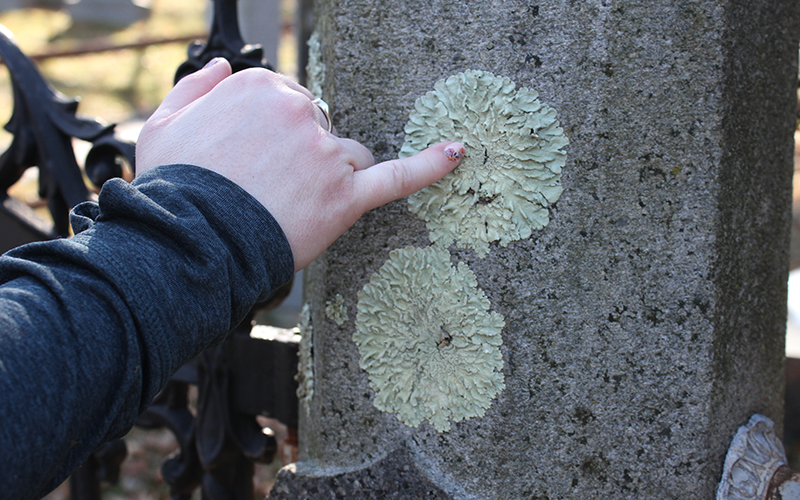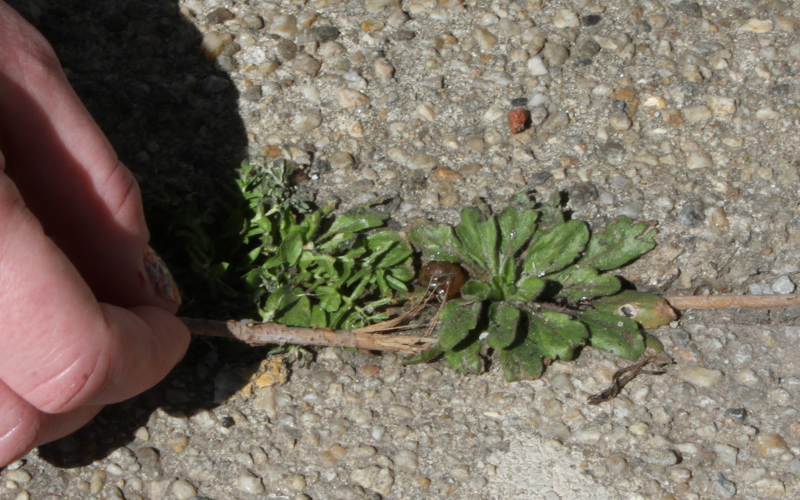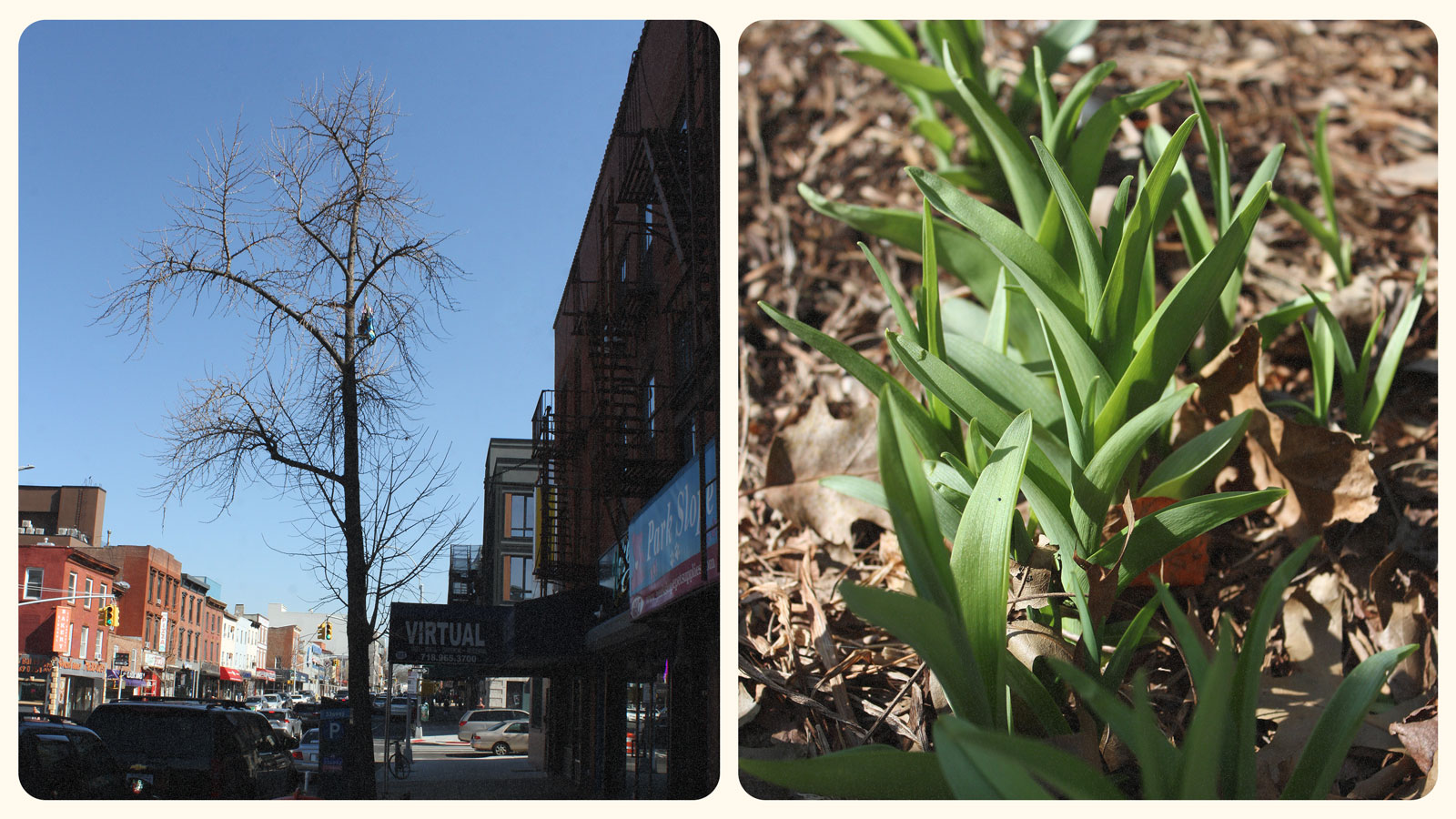This story is part of Fix’s Outdoors Issue, which explores how we build connections to nature, why those connections matter, and how equitable access to outside spaces is a vital climate solution.
Monk parakeets are not native New Yorkers. These chatty, neon green charmers were sent to the States in the 1960s from Argentina, where they were considered pests. Legend has it that they escaped from JFK airport (and evaded a standoff with bird hunters at Rikers Island) to settle where they live today: at the entrance of Green-Wood, a cemetery and historic landmark in western Brooklyn.
The flock, which numbered 36 at last count, stands guard over the 478-acre expanse of greenery and graves. They’ve made a home of the arresting 19th-century Gothic gate, their insulated nests poking out of its main spire like tufts of unwanted hair.
Cemeteries may not be an obvious place to go birdwatching, but neither are the subway tracks of Penn Station, the bike lanes around Union Square, or the banks of the Superfund-designated Gowanus Canal — all areas where my guide, ecologist Kelly O’Donnell, has made numerous nature observations over the years. In her role as director of Science Forward at Macaulay Honors College, O’Donnell teaches students the value of scientific reasoning, often using the surprisingly diverse wildlife of New York City as a case study.

On this unseasonably warm day in late winter, O’Donnell is teaching me how to be more attentive to the teeming natural life in my city. People too often think they must trek to capital-N nature to enjoy the mental and physical boosts of being outdoors, but you can catch glimpses of nature in even the most constructed of places. And spotting, say, a sparrow or a thriving clump of mugwort in the city can elicit similar benefits as walking among redwoods or basking on a coastline.
The trick lies in opening your eyes and taking the time to see — two skills I’d hone in just a few hours walking through the city with O’Donnell.
* * *
My day didn’t start as planned. “Emma, you’re going to a cemetery?” my cab driver asks, breaking my mental replay of having missed one train, finding another delayed indefinitely, then rushing to catch a taxi to meet O’Donnell. By the time I’m in the car, my heart is racing, my thoughts are running on a loop, and I feel on edge.
“Yes, thanks,” I say from the back seat, only to be drowned out by the morning traffic. With a beep, a whir, and a honk, we drive by an asphalt plant, the New York Department of Sanitation, an old shipyard, an air-conditioning repair shop, and a Sunoco gas station — all within the final mile to my destination. Then, suddenly, green appears. My breath deepens, my heart rate slows, and my mind calms.
I step out to find O’Donnell in the grass taking photos of blooming crocuses to post on iNaturalist — a free app where wildlife spotters (professional and amateur) upload photos of flora and fauna to a citizen-science database that monitors biodiversity around the world. In the six minutes she’s been waiting, she’s already recorded a mockingbird and a few sparrows, too.
“Birds that are quieter in the winter are starting to speak up again,” she tells me as we pass beneath our feathered friends and enter Green-Wood’s expanse. Their chirps mask the street noise, and some of my anxieties from the commute along with it.
Science offers a few theories about why simply being in a green space like this can calm us; one of the most widely accepted is the attention restoration theory. The hypothesis, developed by environmental psychologists Rachel and Stephen Kaplan in the 1980s, states that nature provides the brain with a respite from the demands of the modern world (email, push notifications, too many deadlines) and restores cognitive capacity. In other words, it gives our minds a minute to rest. Indeed, people tend to report a better mood and score higher on memory tests after walks in nature than they do after walks in urban environments. Getting outside also seems to decrease our ruminative thoughts — the type of sticky, repetitive ones I experienced in the cab.
Beyond helping our brains relax and recoup, nature can soothe our emotions. Research has found time and again that being among greenery can ease stress and its physical manifestations (spiking cortisol levels, rising blood pressure) and promote positive sentiments like joy, satisfaction, and belonging.
As the rolling hills of the cemetery lead us to a lookout point over Manhattan, I feel another emotion that is hard to ignore outside: awe. This feeling, typically triggered in the presence of something mind-bogglingly vast or beautiful, can cause us to reconsider our place in the world, feel less fixed in our ways, and adopt a sense of curiosity.
“Most people are terrified of changing how they see things or revising their knowledge,” Melanie Rudd, an associate professor at the University of Houston who studies awe, explains in my book Return to Nature. “But awe surrounds that cognitive component in a positive feeling, a positive experience, and it is one of the few states in which altering the way you see things is not threatening.”

Perhaps awe is what helped O’Donnell and me notice the family of tiny red-eared slider turtles touring the cemetery pond, or the lichen that had latched onto a gravestone and grown in the shape of a flower. As O’Donnell tells me about the 20-odd types of warblers she and her students spotted the last time she was here, I ask her if being an ecologist in the Big Apple ever makes her feel robbed, like she’s missing out on the “real” nature beyond city lines. “I don’t ever feel starved for nature,” she says, not missing a beat, “because I’m always looking for it.”
* * *
Most of the research into the benefits of nature has combined residential address data with satellite imagery to see if access to green spaces contributes to better health. So far, the answer has been a resounding yes. People who live in greener areas seem to have lower rates of obesity, cardiovascular disease, diabetes, and even mortality, as reported by Harvard researchers in a 2016 study of more than 100,000 U.S. women.
Studies like these may lead people to think “green space” means, say, Yellowstone, or at the very least Central Park. Not so, says Peter James, an environmental epidemiologist involved in the 2016 Harvard study. “The majority of research is done on people living in urban settings,” he tells me. “We’re looking at vegetation data around people’s homes, and that’s where we’re seeing the strongest findings. Our research doesn’t necessarily show that it has to be super wild. It could just be a green space within your urban setting.”
Spotting, say, a sparrow or a thriving clump of mugwort in the city can elicit similar benefits as walking among redwoods or basking on a coastline.
In other words, while trips to, say, the woods or the lake are great, neighborhood nature — the type that we encounter every day — seems to have the biggest impact on our health. When you can’t make it to a park, paying a visit to that tree down the street will do.
With this in mind, I ask O’Donnell if we could venture beyond Green-Wood and into the busy streets of Brooklyn. While the biodiversity we spotted in the cemetery was glorious, it wasn’t all that surprising. I was curious if there was anything to see among the bodegas, brownstones, and bicycles that could lower my heart rate and settle my mind in a similar way.
With every step away from the serenity of Green-Wood, the soundtrack of the Anthropocene grows louder, and the sweet smells of sassafras give way to the stale stench of trash. Yet it takes only a minute for O’Donnell to make her first sighting. “Look up there,” she says, loud enough to be heard over traffic. She points to a flock of sparrows nestled in the nooks of an old bank. She tells me that predators like red-tailed hawks also settle on tops of buildings, where they can easily prey on tasty pigeons.
Eyes to the sky, we see northern mockingbirds flying in and out of the street lights that line South Park Slope’s 5th Avenue, the fixtures providing a cozy retreat from the bustle below. On a block shaded by scaffolding, we look up to see what can only be described as a hotel of sparrows, nearly a dozen of them carrying sticks in their beaks to construct temporary nests in the steel planks. It’s an entire world playing out above our heads, one I would have probably missed on any other day.

It’s addicting, this thrill of discovering things that have been there all along. O’Donnell and I mosey along the blocks, checking every tree and patch of grass for signs of life (we find lots of trash, but also some mugwort and seedlings too small to identify). O’Donnell tells me to pay special attention to the cracks in the concrete, where hardy plants are known to sprout. “Wait, wait!” she calls out as I walk ahead. “There’s a snail in here. Do you have a stick?” I pass her a twig and she gently unearths a spiral shell — which fellow iNaturalist users later helped her identify as Oxychilus, a type of land snail — nestled in some green on the sidewalk.
We make our way to the waterfront to see what there is to see there. Getting to the Gowanus Canal — New York’s famously contaminated waterway that served as a chemical dumping ground for decades — required walking through the most industrialized area we’ve hit yet. Concrete buildings, seemingly abandoned, loomed over an eerily quiet street flanked by cars. The sounds of people were gone, but so were the birds. Even with my newly practiced observation skills, I couldn’t catch any glimpses of green.
Eventually, we land at a small patch of beach behind a wire fence. “Beach” is a generous term. The waterfront is buried under all manner of debris: a dilapidated wood platform, a tire, a soccer ball, and other remnants of times unknown. “Sometimes the plastic bags look a little bit like seaweeds,” my walking partner notes, our heads pressed against the chain-link fence.
“But, oh, there’s milkweed there! That’s a native plant that butterflies love,” O’Donnell says, pointing to tufts of soft flowers poking through jagged edges of rock. “And water chestnut — an invasive with some nasty-looking seed pods.” We spend a few minutes like this, making our way through the interplay of humanity’s refuse and nature’s castaways. The more we look, the more we find. A sparrow flies gracefully overhead, landing on a rock coated in canary-yellow seaweed. Out of the corner of my eye, I spot a makeshift nest in the rubble. Plants and animals I once took for granted I now see as part of a thriving ecosystem — and an incredibly resilient one at that. O’Donnell guesses that the cedarlike shrubs dotting the area had been planted at some point. “Everything else,” she tells me, “got here on its own.”
On our walk back to Green-Wood, I see a small, crimson plant we missed on the way in. Its red tips, O’Donnell tells me, are likely a pigment the flora, which I later learn is a variety called Plantago, creates as UV protection. I kneel down with respect for a closer look at the scrawny thing fighting through concrete for its moment in the sun.
* * *
I worry that I’ll turn as red as that plant if we don’t move along. With no trees for protection, this place is getting uncomfortably hot. I’m not surprised to discover that the city has declared the neighborhood an environmental justice area — a low-income community that lacks greenery.
It’s a reminder that in this city, like so many others, amenities like parks and trees are not distributed equitably. Of the 164 cities worldwide included in the Urban Environment & Social Inclusion Index (which maps demographic indicators like income against environmental indicators such as air pollution), underserved communities tend to have less green space and tree cover. As a result, their residents live with higher exposure to pollutants and heat.
In the U.S., this inequality stems in part from redlining — the decades-long practice of denying home loans and other financing to people of color, leaving many communities underfunded and without amenities like parks to this day. Of the 175 cities in the U.S. with a population of over a quarter-million people, 113 have former redlined communities, says Angel Hsu, an environmental policy expert and assistant professor at UNC-Chapel Hill (and 2016 Grist 50 honoree). Yet even in cities that were not redlined, “We’re still seeing the same persistent pattern of lower-income people and people of color being exposed to higher levels of urban heat,” says Hsu, who leads the group that created the social inclusion index. “Our research has shown that redlining alone does not explain the full picture.” By making this data easily accessible, Hsu’s team hopes to help cities right these historical wrongs and more equitably distribute their greenery.
“Nature is not a perk. Nature is not an amenity. Nature should be a human right.”
— Peter James, environmental epidemiologist
It’s essential work, given that reintroducing nature in areas like the Gowanus Canal can be a boon to public health. Research is finding that low-income groups tend to reap more health benefits from neighborhood green space than the more affluent. This is in part because they often rely on scant public amenities like parks and beaches. Greening may also help promote neighborhood cohesion and safety, according to fascinating research out of Philadelphia in which the city cleared a random sampling of vacant lots and landscaped them with grass and trees. “We found significant decreases in all crimes, especially in gun violence, around the intervention lots after they were cleaned and greened,” social scientist and study author Michelle Kondo says.
By the time our walk comes to a close, it’s clear to me that the value of green space extends beyond keeping us cool and comfortable to keeping us mentally stimulated, curious, and relaxed. In other words, it keeps us human. In an age when technology and the built environment are crowding out so much, these areas of retreat are indispensable. As Peter James, the environmental epidemiologist at Harvard told me, “Nature is not a perk. Nature is not an amenity. Nature should be a human right.”
* * *
With the parakeets still buzzing overhead, O’Donnell and I end our walk back. It feels like days have passed since my hectic ride into Green-Wood, though when I check my watch I see that it’s been less than three hours. Over the course of our 13,200 steps covering 5.81 miles, O’Donnell has made 31 iNaturalist observations, from the sidewalk snail to the busy sparrows constructing among the construction. We wave goodbye and I walk under the birds roosting the gate to Green-Wood one last time. My hair is a mess and I smell like I just finished a days-long camping trip, not a short urban hike. But I don’t care; I like this version of myself. For a moment, I hesitate to catch a cab and return to the city. Then, I remember I never really left.
Correction: An earlier version of this story misidentified an Oxychilus snail. This post has been updated.
Explore more from Fix’s Outdoors Issue:
- How outdoor experiences have shaped today’s climate and justice leaders
- An Indigenous Bible translation reframes Christianity’s connection to nature
- How virtual reality and other tech are capturing nature’s most threatened places





